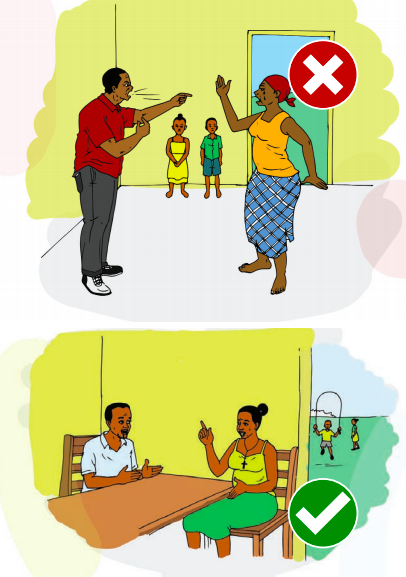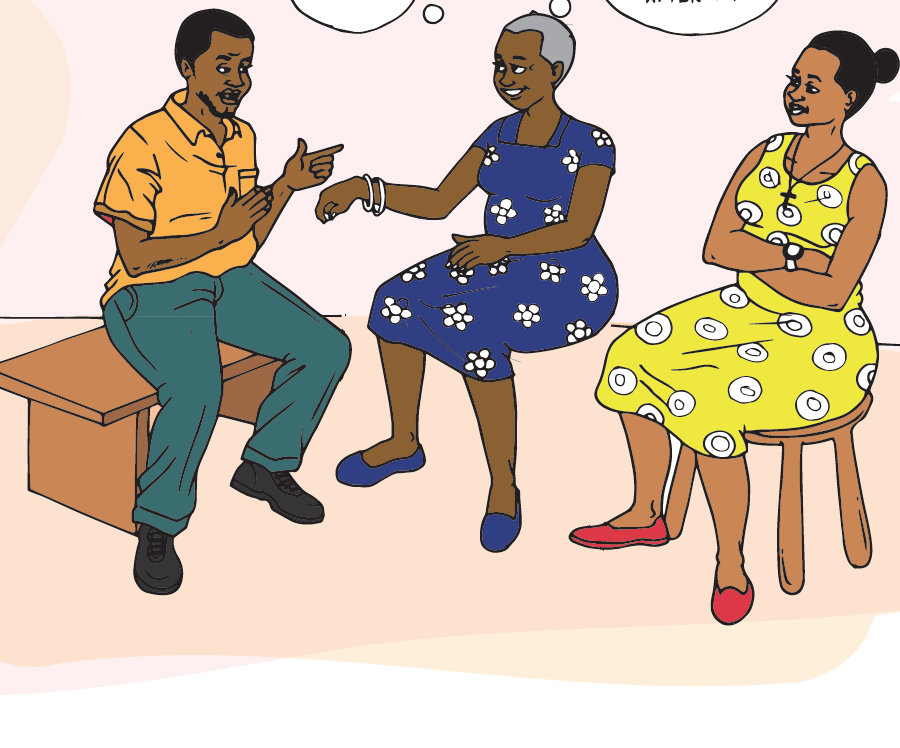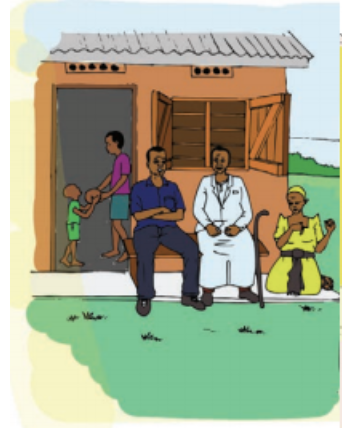Communication with children and their exposure to conflict

Parents should be careful about the information that they share and how they deal with conflict in front of their children.
When parents are facing a family conflict such as separation, they should always think about the best interests of their children. The family situation can be very difficult and emotionally challenging. Therefore, parents should know how to communicate.
The information that parents share with their children should be appropriate and constructive. Parents should not share negative information about the other parent, such as complaints on lack of child-support. Parents should not share sensitive information such as on financial issues, the reason for divorce and personal concerns. Sharing such inappropriate information with children negatively affect their wellbeing.
Children should be able to make sense of their parent’s dispute. At the same time, parents should limit the exposure of their conflict. Children’s exposure to marital conflict can place them in an uncomfortable position as mediators, which negatively influences their wellbeing.
Abazadde balina okwegendereza bikyi byebagamba abaana n’engeri gyebakwatamu obutakkanya ng’abaana webali
Abazadde bwe babeera nga balina obutakkanya mu maka, balina okukulembeza obulungi bw’abaana mu buli kaseera. Akaseera kano kabera kazibu era kabakalubirira nnyo. N’olwekyo, abazadde balina okumanya engeri y’okwogerezeganya.
Ebintu abazadde bye bagamba abaana babwe birina okubeera nga bibamala era na bibazimba. Abazadde tebalina kwogera bibi ku muzadde munaabwe, okugeza ng’obutabawa buyambi bw’abaana. Abazadde tebalina kubagamba bintu bya buziba okugeza ng’obuzibu mu by’enfuna oba ebiberarikiriza nga bbo. Okubagamba ebintu ng’ebyo ebitali birungi bireteera abaana okukosebwa nga bakula.
Abaana balina okuba nga bategeera enjawukana eziri wakati w’abazadde babwe. Mu buufu bwebumu, abazadde balina okugezaako obutabalaga nnyo nti balina obutakkanya wakati wabwe. Okubuulira abaana nti bazadde babwe balina obutakkanya kibateeka mu kifo ekizibu ng’abatabaganya, ekibakosa nga bbo.
What practitioners say
Consistent with literature research:
Use constructive communication. Rather than use hurtful or insulting words about the other partner, be positive in communication with children. Try to give children confidence. Show them that the changes will be in their best interest.
Beware of sharing information about emotions. Avoid sharing information about frustration with specific actions of other family members.
Ensure that children know they are not responsible in any way. Let children know that the issues between parents are between parents only. Explain that both parents love their children.
Give children room to ask about the new family situation. Give children the space to ask follow-up questions. Ask them to summarize what you have communicated to ensure it is well understood. Avoid dismissing ‘tricky’ questions. Follow-up on communication regularly to make sure children are processing the information well.
Take the time to explain the situation. Make sure children understand the changing family situation and the effect it may have on the family structure.
Avoid involving the child in the disagreements. Be open about the misunderstandings or disagreements in a friendly manner. Do not ask them to take sides in the conflict. Do not use them in bargaining situations.
Avoid involving children in sensitive conversations. Children should not be present in conversations of sensitive nature, this goes for any dialogue, negotiation, mediation or court hearing.
Keep children away from sensitive conversations between parents. Children should not be present in conversations of sensitive nature, this might include conversations during dialogue/negotiation, mediation or court hearings.
Do not share sensitive information about children in their presence. Children should not be present when sensitive information is shared between parents.
Do not use or manipulate children in a conflict. Conflicts between parents should not influence the ability of both parents to be a part of their children’s lives. Don’t ask them to choose sides.
Assess the communication levels of the child. Depending on age and maturity of children, they may need different communication styles. Make sure that communication is tailored to the age and situation of the children.
Focus on what is important and what is in the best interest of the child. Think in terms of providing solutions for children.
Seek help before the conflict affects children’s health. If a child is showing signs of (mental) health problems as a consequence of the conflict, seek professional help on time.
Encourage children to build a strong relationship with both parents. Enable the child to build his/her own relationship with the other parent without influencing that relationship.
Other suggested best practices:
Ensure the children are informed and their voices are heard. Give the child a voice. Listen to them and inform them. Use language that children understand.
There should be no gender bias in dealing with children. Both parents should be involved with both their son and daughter. No parent can give preference to any of the genders.
Make sure children’s emotional needs are well addressed. For example during puberty children may need extra support.
Be mindful of privacy of children (especially teenagers). Do not freely share sensitive information about children to other members outside of the family.
Ziri ku mulamwa n’okunonyereza okuli mu biwandiiko:
Kkozesa enjogerezeganya ezimba. Mu kifo ky’okwogera ku munno ng’okozesa ebigambo ebivuma oba ebiruma, yogerezeganya bulungi n’abaana. Gezaako okuwa abaana obuvvumu. Balage nti enkyukakyuka zigya kubeera ku lw’obulungi bwabwe.
Wegendereze obutabuulira balala bw’owulira muli. Wewale okubuulira abalala bw’owulira muli naddala nga bikwata ku omu ku b’awaka by’akola nga bikunyiza.
Kkakasa nti abaana bakitegeera nti omusango ssi gwabwe. Abaana balina okukimanya nti ebigenda mu maaso wakati w’abazadde babwe biri wakati babwe bokka. Nnyonnyola nti abazadde bombi bagala abaana babwe.
Abaana baweebwe omukisa okubuuza ebibuzo ku bigenda mu maaso.
Abaana bawe obudde okubuuza ebibuuzo ku bigenda mu maaso. Bagambe bakuddiremu by’obagambye mu bufunze okakase nti babitegedde bulungi. Wewale obutaddamu ebibuuzo ebizibuzibu. Beera ng’obakeberako okulaba oba byewabagamba babifuna bulungi.
Twala obudde okunnyonnyola embeera. Kkakasa nti abaana bategeera bulungi embeera y’amaka ekyuka na biki ebinavaamu na ddala mu nsengeka y’amaka.
Wewale okuyingiza abaana mu butakiriziganya. Beera mulambulukufu ku butategeregana oba obutakiriziganya mu ngeri y’omukwano. Tobagamba kulondako ludda mu butakkanya. Tobakozesa mu kuteseganya.
Wewale okuyingiza abaana mu mboozi ez’ebuziba. Abaana tebalina kubeerawo ng’emboozi ez’ebuziba zoogerwa, kino kizingiramu okwogerezeganya kwonna, enteeseganya, okutabaganya oba okugenda mu kkooti.
Abaana tobateeka mu mboozi z’ebuziba wakati w’abazadde. Abaana tebalina kubeerawo ng’abazadde boogera emboozi z’ebuziba, nga mwemuli okwogerezeganya, okuteeseganya, okutabaganya oba okugenda mu kkooti.
Toyogera bintu bya buziba ebikwata ku baana nga webali. Abaana tebalina kubeerawo ng’abazadde boogera ebintu eby’ebuziba.
Tokozesa oba tokyanga baana mu butakkanya. Obutakkanya obuli wakati w’abazadde tebulina kukyusa mu ngeri abazadde gyebabeera mu bulamu bw’abaana babwe. Tobagamba kulondako ludda.
Mpimamu enjogerezeganya y’omwana. Okusinzira ku myaka n’obukulu bw’omwana, engeri z’okw’ogerezeganya ziyinza okubeera ez’enjawulo. Kkakasa nti engeri gy’oyogera mu n’omwana egya mu myaka gye n’ebigenda mu maaso.
Essira liteeke ku bintu ebikulu era eby’olw’obulungi bw’omwan. Lowooza mu ngeri ey’okuwa abaana eby’okuddamu.
Ffuna obuyambi ng’obutakkanya tebunakosa bya bulamu bwa mwana. Omwana bw’abeera atandise okufuna obuboner bw’okukosebwa (ku mutwe) nga kiva ku butakkanya, ffuna obuyambi okuva mu bakuggu ng’obudde bukyali.
Kkubiriza omwana okuzimba enkolagana enungi n’abazadde bombi. Yamba ko omwana mu kuzimba enkolagana ye nga ye n’omuzadde omulala nga tomusindikiriza.
Ebirala ebiyinza okukolebwa:
Kkakasa nti abaana bamanyi ekigenda mu maaso era n’endowooza zabwe ziwulirizibwa. Omwana muwe eddoboozi. Bawulirize er’obategeeze. Kkozesa olulimi abaana lwe bategeera.
Tewalina kubeerawo kusosola mu baana olw’ekikula kyabe. Abazadde bombi balina okwenyigira mu nsonga za mutabani ne muwala wabwe. Teri muzadde alina kulondako mwana wa kikula kimu.
Kkakasa nti ebyetaago by’abaana eby’omunda bikolebwako bulungi. Okugeza mu myaka nga batandise okuvubuka abaana bayinza okwetaaga obuyambi obw’enjawulo.
Wegendereze ebintu by’abaana ebikuusike (naddala abattiini). Tomala gaasanguza bikwata ku baana eri abantu abalala abatali b’awaka.
Resources and Methodology
Disclosure of information to children
During a first assessment of the available literature, we were able to identify an intervention for sharing information with children, this being: parents limiting the disclosure of information about the separation
For children, is actively limiting disclosure of information about the other parent more effective than sharing all information for their well-being?
The databases used are: HeinOnline, Westlaw, Wiley Online Library, JSTOR and Taylor & Francis.
For this PICO question, keywords used in the search strategy are: communication, parental conflict, separation, divorce, children, information, revealing, disclosure.
The three main sources used for this particular subject are:
- Matthew R. Sanders, W. Kim Halford and Brett C. Behrens, Parental Divorce and Premarital Couple Communication (1999)
- Tamara D. Afifi, Tara McManus, Susan Hutchinson and Birgitta Baker, Inappropriate Parental Divorce Disclosures, the Factors that Prompt them, and their Impact on Parents’ and Adolescents’ Well-Being (2007)
- Paul Schrodt and Tamara D. Afifi, Communication Processes that Predict Young Adults’ Feelings of Being Caught and their Associations with Mental Health and Family Satisfaction (2007)
The article by Sanders, Halford and Behrens is based on a detailed observational analysis of couples’ interaction. The article by Afifi, McManus, Hutchinson and Baker bases its findings mostly on clinical and empirical evidence. The article by Schrodt and Afifi uses both empirical and meta-analysis to support its findings. According to the HiiL Methodology: Assessment of Evidence and Recommendations, the strength of this evidence is classified as ‘low’ to ‘moderate.’
Desirable outcomes
It is important to note that, based on uncertainty reduction theory, children need some information about the separation in order to reduce their uncertainty about the state of their family (Afifi, McManus, p. 80).
Undesirable outcomes
Research has shown that parents’ inappropriate disclosures give children psychological distress, physical ailments and feelings of being caught between their parents (Afifi, McManus, p. 79). Examples of inappropriate information are: negative information about the other parent (including complaints on lack of child-support), sensitive information and information judged not to be suitable (such as on financial issues, the reason for separation and personal concerns of the parent), and information that makes children feel caught between their parents (Schrodt, p. 209).
If children are completely uninformed about the separation, they can feel deceived, which can produce mistrust, diminished satisfaction with their parental communication, and a fear of establishing committed romantic relationships upon maturity (Afifi, McManus, p. 80). It can be difficult to for some parents to determine the fine line between disclosing the right amount of information and inappropriate information.
Balance of outcomes
In determining whether actively limiting disclosure of information to children about the other parent is more effective than sharing all information for their well-being, the desirable and undesirable outcomes of both interventions must be considered.
The available literature suggests that certain information is not to be disclosed for the sake of the wellbeing of the child. In particular, revealing negative information about one parent would have severe negative effect physically and psychologically in both the long and short term. This type of information is classified as ‘inappropriate’.
However, it is important to keep in mind that children should be informed during the separation process.
Recommendation
In light of the undesired outcomes of revealing inappropriate information to children, we make the following recommendation: For the well-being of children, it is appropriate that parents disclose information on the separation, albeit in a considered and limited way.
Exposure of children to conflicts
During the orientation process of the available literature, we were able to identify one intervention, this being: limiting the exposure of children to severe parental conflicts.
For children, is actively limiting the exposure of children to severe parental conflicts more effective than not doing this for their well-being?
The databases used are: HeinOnline, Westlaw, Wiley Online Library, JSTOR and Taylor & Francis.
For this PICO question, keywords used in the search strategy are: communication, parental conflict, separation, divorce, children.
The three main sources used for this particular subject are:
- Matthew R. Sanders, W. Kim Halford and Brett C. Behrens, Parental Divorce and Premarital Couple Communication (1999)
- Tamara D. Afifi, Tara McManus, Susan Hutchinson and Birgitta Baker, Inappropriate Parental Divorce Disclosures, the Factors that Prompt them, and their Impact on Parents’ and Adolescents’ Well-Being (2007)
- Paul Schrodt and Tamara D. Afifi, Communication Processes that Predict Young Adults’ Feelings of Being Caught and their Associations with Mental Health and Family Satisfaction (2007)
The article by Sanders, Halford and Behrens is based on a detailed observational analysis of couples’ interaction. The article by Afifi, McManus, Hutchinson and Baker bases its findings mostly on clinical and empirical evidence. The article by Schrodt and Afifi uses both empirical and meta-analysis to support its findings. According to the HiiL Methodology: Assessment of Evidence and Recommendations, the strength of this evidence is classified as ‘low’ to ‘moderate’.
Desirable outcomes:
Adaptive communication behaviours can be learned. Therefore, the problems that children face as a result of exposure to a parental conflict can be prevented (Schrodt, p. 62). In this regard, training children in cognitive and behavioural skills might be beneficial.
If the training is extended to parents, they are able to become aware of how communication impacts others. If children are to try and make sense of their parents’ disputes, then becoming privy to additional information relevant to such disputes and marital conflicts may increase their satisfaction and mental health by reducing the uncertainty and stress associated with making sense of it all (Schrodt, p. 223).
Undesirable outcomes:
Children’s exposure to marital conflicts can place them in an uncomfortable position as mediators (Schrodt, p. 204). When parental disclosures produce role changes or make them feel caught between their parents, it may result in psychological and behavioural problems for adolescents (Afifi, McManus, p. 81). When parental separation is associated with exposure of children to severe parental conflict, this means children also get exposed to models of maladaptive conflict management behaviours (Sanders, p. 61). When children take over these interaction habits, then they are put at greater risk for relationship problems as adults (Sanders, p. 61).
Balance of outcomes:
In determining whether actively limiting the exposure of children to severe parental conflicts is more effective for their well-being than omitting this, the desirable and undesirable outcomes of both interventions must be considered.
The literature suggests that exposure to marital conflicts has negative effects on children’s well-being. It can place them in the position of a mediator and it can make them feel caught between their parents. Moreover, exposure to a marital conflict can have negative consequences to the well-being of children in the long term.
On the other hand, children need to make sense of their parents’ marital conflict. Therefore, the balance between outcomes is not entirely clear.
Recommendation:
Despite the unclear balance of outcomes in terms of children’s well-being, we make the following recommendation: For children, actively limiting the exposure of children to severe parental conflicts is more effective than not doing this for their well-being.


